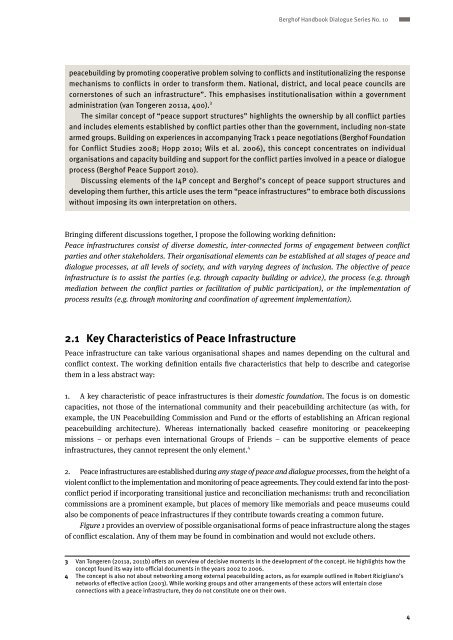Giving Peace an Address? - Berghof Handbook for Conflict ...
Giving Peace an Address? - Berghof Handbook for Conflict ...
Giving Peace an Address? - Berghof Handbook for Conflict ...
Create successful ePaper yourself
Turn your PDF publications into a flip-book with our unique Google optimized e-Paper software.
<strong>Berghof</strong> H<strong>an</strong>dbook Dialogue Series No. 10<br />
peacebuilding by promoting cooperative problem solving to conflicts <strong>an</strong>d institutionalizing the response<br />
mech<strong>an</strong>isms to conflicts in order to tr<strong>an</strong>s<strong>for</strong>m them. National, district, <strong>an</strong>d local peace councils are<br />
cornerstones of such <strong>an</strong> infrastructure”. This emphasises institutionalisation within a government<br />
administration (v<strong>an</strong> Tongeren 2011a, 400). 3<br />
The similar concept of “peace support structures” highlights the ownership by all conflict parties<br />
<strong>an</strong>d includes elements established by conflict parties other th<strong>an</strong> the government, including non-state<br />
armed groups. Building on experiences in accomp<strong>an</strong>ying Track 1 peace negotiations (<strong>Berghof</strong> Foundation<br />
<strong>for</strong> <strong>Conflict</strong> Studies 2008; Hopp 2010; Wils et al. 2006), this concept concentrates on individual<br />
org<strong>an</strong>isations <strong>an</strong>d capacity building <strong>an</strong>d support <strong>for</strong> the conflict parties involved in a peace or dialogue<br />
process (<strong>Berghof</strong> <strong>Peace</strong> Support 2010).<br />
Discussing elements of the I4P concept <strong>an</strong>d <strong>Berghof</strong>’s concept of peace support structures <strong>an</strong>d<br />
developing them further, this article uses the term “peace infrastructures” to embrace both discussions<br />
without imposing its own interpretation on others.<br />
Bringing different discussions together, I propose the following working definition:<br />
<strong>Peace</strong> infrastructures consist of diverse domestic, inter-connected <strong>for</strong>ms of engagement between conflict<br />
parties <strong>an</strong>d other stakeholders. Their org<strong>an</strong>isational elements c<strong>an</strong> be established at all stages of peace <strong>an</strong>d<br />
dialogue processes, at all levels of society, <strong>an</strong>d with varying degrees of inclusion. The objective of peace<br />
infrastructure is to assist the parties (e.g. through capacity building or advice), the process (e.g. through<br />
mediation between the conflict parties or facilitation of public participation), or the implementation of<br />
process results (e.g. through monitoring <strong>an</strong>d coordination of agreement implementation).<br />
2.1 Key Characteristics of <strong>Peace</strong> Infrastructure<br />
<strong>Peace</strong> infrastructure c<strong>an</strong> take various org<strong>an</strong>isational shapes <strong>an</strong>d names depending on the cultural <strong>an</strong>d<br />
conflict context. The working definition entails five characteristics that help to describe <strong>an</strong>d categorise<br />
them in a less abstract way:<br />
1. A key characteristic of peace infrastructures is their domestic foundation. The focus is on domestic<br />
capacities, not those of the international community <strong>an</strong>d their peacebuilding architecture (as with, <strong>for</strong><br />
example, the UN <strong>Peace</strong>building Commission <strong>an</strong>d Fund or the ef<strong>for</strong>ts of establishing <strong>an</strong> Afric<strong>an</strong> regional<br />
peacebuilding architecture). Whereas internationally backed ceasefire monitoring or peacekeeping<br />
missions – or perhaps even international Groups of Friends – c<strong>an</strong> be supportive elements of peace<br />
infrastructures, they c<strong>an</strong>not represent the only element. 4<br />
2. <strong>Peace</strong> infrastructures are established during <strong>an</strong>y stage of peace <strong>an</strong>d dialogue processes, from the height of a<br />
violent conflict to the implementation <strong>an</strong>d monitoring of peace agreements. They could extend far into the postconflict<br />
period if incorporating tr<strong>an</strong>sitional justice <strong>an</strong>d reconciliation mech<strong>an</strong>isms: truth <strong>an</strong>d reconciliation<br />
commissions are a prominent example, but places of memory like memorials <strong>an</strong>d peace museums could<br />
also be components of peace infrastructures if they contribute towards creating a common future.<br />
Figure 1 provides <strong>an</strong> overview of possible org<strong>an</strong>isational <strong>for</strong>ms of peace infrastructure along the stages<br />
of conflict escalation. Any of them may be found in combination <strong>an</strong>d would not exclude others.<br />
3 V<strong>an</strong> Tongeren (2011a, 2011b) offers <strong>an</strong> overview of decisive moments in the development of the concept. He highlights how the<br />
concept found its way into official documents in the years 2002 to 2006.<br />
4 The concept is also not about networking among external peacebuilding actors, as <strong>for</strong> example outlined in Robert Ricigli<strong>an</strong>o’s<br />
networks of effective action (2003). While working groups <strong>an</strong>d other arr<strong>an</strong>gements of these actors will entertain close<br />
connections with a peace infrastructure, they do not constitute one on their own.<br />
4
















